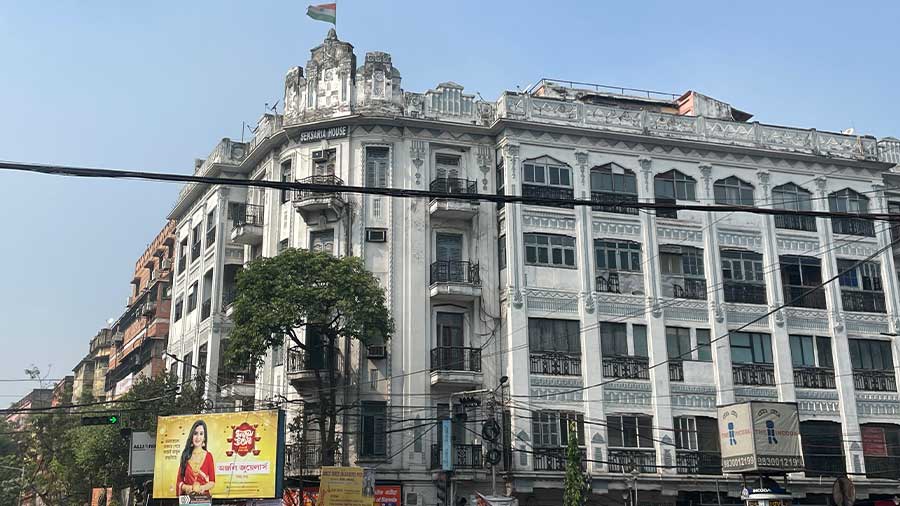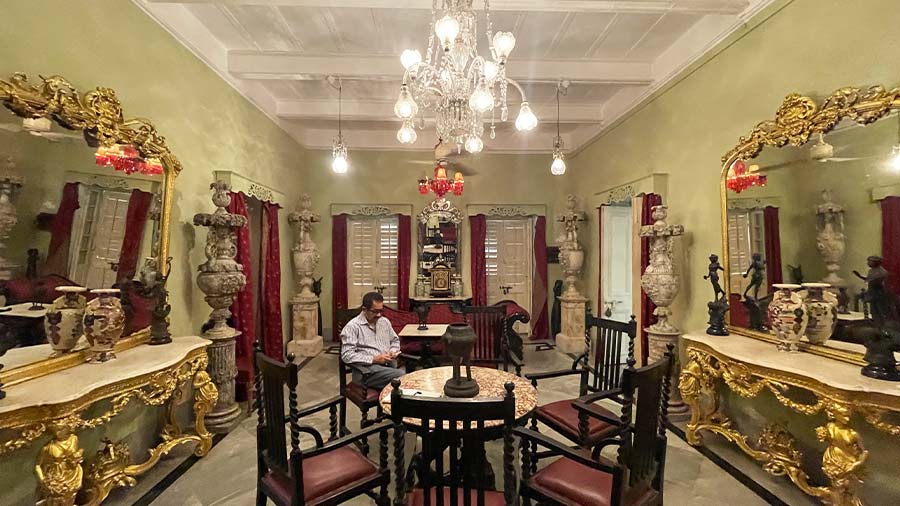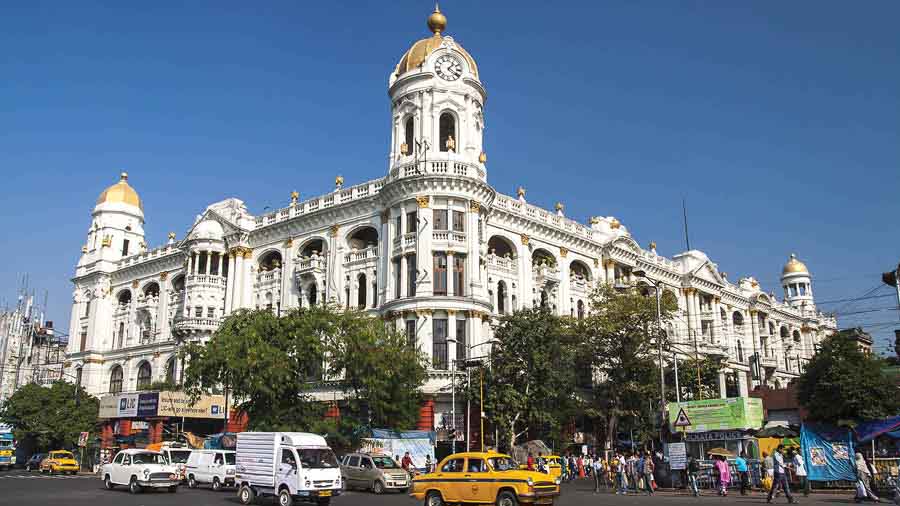If you are driving southwards through Chittaranjan Avenue and halting at the Vivekananda Road crossing, there is a likelihood that your attention will be drawn to a white four-storeyed structure at the ‘eleven o’ clock’ position beyond the traffic signal. This structure is a Girish Park landmark that most people use as a reference – ‘take the first lane after the building’ or ‘turn right when you see that white building at the diagonal left.’ When the owners of this structure went to a Dubai wedding, they were surprised when the person to whom they were being introduced, said, ‘Arre, aap toh crossing waale Seksaria hain!’
Seksaria House graduated to a metaphor for stateliness. Even as the structure was built by affluent migrants, there is little of Rajasthan on the façade; the façade can be considered closer in scale and spread to the Alexandra Courts and King Edward Courts of the city without extensive foreign design embellishments – possibly an attempt to seek a differently non-aligned grammar. There is no ‘Let us remember where we came from’; there is no ‘let us imitate the rich and famous’ either. The façade stands as a motif of what may have been considered the architectural equivalent of the ‘modern Indian’ in the Thirties of the last century.
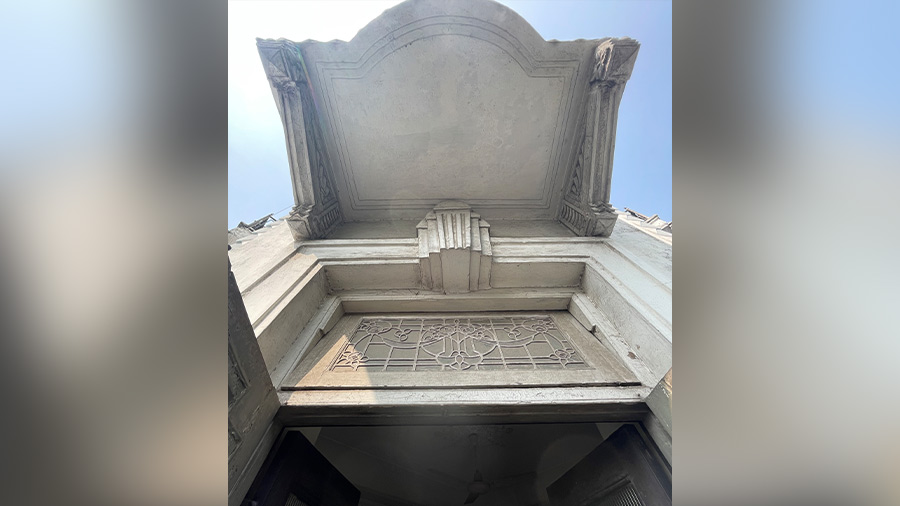
Even as the structure was built by affluent migrants, there is little of Rajasthan on the façade
Curiously, this distinctive architectural grammar changes from the moment one crosses the chaukhat (threshold) of Seksaria House. For a stately building of this kind, the main entrance is only about six-feet wide, almost to the point that one may miss it if walking down Chittaranjan Avenue. Imagine an aggregated frontage of more than 250 feet across all four sides and an entrance as narrow as this. Most architects would have pressed the case for a large two-gated grilled entrance with a driveway, but perhaps the Seksarias were canny enough to recognise that a large driveway would have eaten into their monetisable property.
The Seksarias compensated architecturally instead. With marble. There is perhaps no structure on Chittaranjan Avenue with as rich a marble strain as I have seen in Seksaria House; the slab whiteness, largeness and extensiveness impress as soon as you enter; even the two ‘rowaks’ adjoining the ante-corridor leading to the central chowk are marble-rich; the promoters could have overlooked the use of marble in a drivers’ seating area on the grounds that ‘Apne to wahan baithne wale nahi, so why spend extra?’ Besides, I can almost imagine the paterfamilias bellowing from the third floor ‘Chai ka bhaand koi marble pe nahi rakkhega!’

Even the two ‘rowaks’ adjoining the ante-corridor leading to the central chowk are marble-rich
Walk a few steps through the corridor and you enter the chowk area, my first indication that this is perhaps a Rajasthan-inspired structure. The architects of the last century focused on complete symmetry as one way of pleasing their principal; the day-view from the middle of the chowk is reasonable, but the night view is possibly the most attractive of all chowk kinds in the city (with the possible exception of the ‘twin sisters’ of Nando Mullick Lane). The chowk is clean, square and marbled; there is a second chowk at the rear of the building; the lenient gateman is perhaps used to admiring strangers walk in, crane their neck upwards, shoot a couple of pictures, shake their head in wonder and leave. He continues looking into his mobile phone without as much as asking ‘Yahan kisko milna hain?’
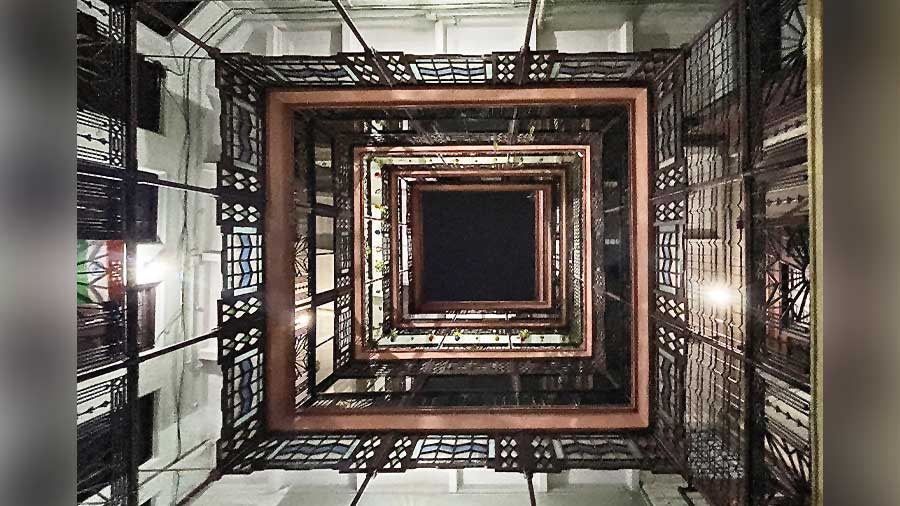
The night view is possibly the most attractive of all ‘chowk’ kinds in the city
The terrestrial wonder of the chowk is the elevator, the first on Chittaranjan Avenue in the late Thirties. When it was first installed, there was an unspoken apprehension (‘Chadhe ki nahin?’) The owners built for the future. The lift is operated manually by a dedicated liftman (a luxury considering that no more than 20 people reside within today); the metal ‘Jessop’ board is periodically cleaned; the mention of the word ‘lift’ is backed by an immediate family suffix (‘motor original’); the wooden gate of the lift is the kind I have not seen elsewhere. The lift was not just installed; it was celebrated. Still continues to be.
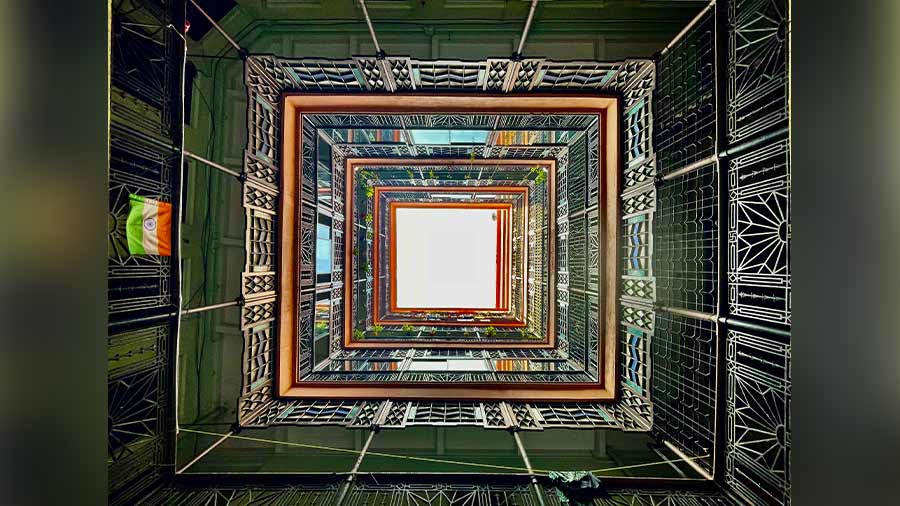
The day view from the middle of the chowk
So much for the mechanical fine print. It is the stories that make Seksaria House compelling.
Ramnath Seksaria may have continued living in a tenanted home in More House – another grand Chittaranjan Avenue beauty – had it not been for a fallout with the makaan malik. The proud Ramnath vacated in a huff the following day and moved the Seksaria clan to Parbati Ghosh Lane in an obscure north Calcutta bylane, where was germinated the blueprint to move into a residence more grand and permanent. It was not the blueprint or the grandness that emerged that was important; it is how a family of considerable affluence lived in a tenanted premises and now decided almost overnight to make the leap to ‘live in what is going to be ours.’ Grandly.
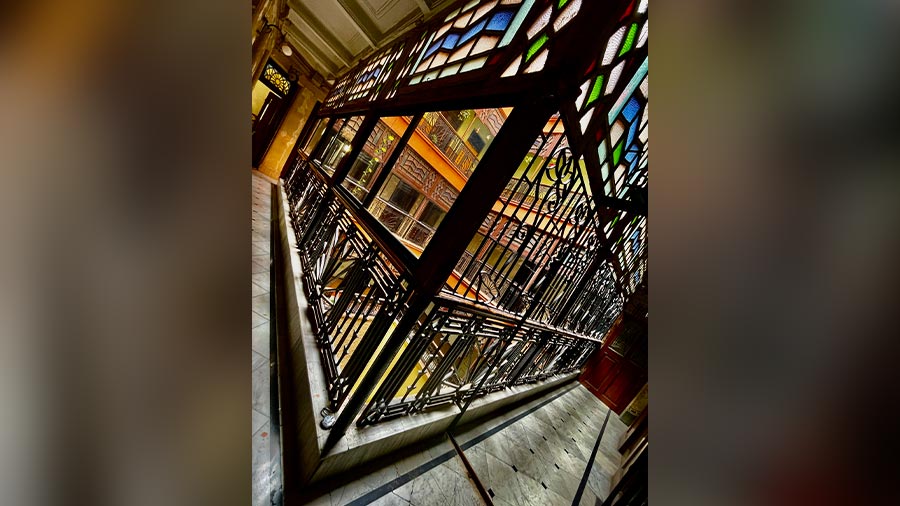
Corridors around the chowk
Ramnath paid twice the usual cost of the 10 cottahs for this corner of the road when the seller – a smart negotiator – slipped in the line about ‘Purab se surya bhagwaan ki roshni’ and ‘The only concrete road east of London’. The seller also possibly emphasised how a road as broad as this would emerge as the principal connector between Chowringhee and north Calcutta (Chitpur being relegated to a country cousin and Lower Circular Road being dismissed as too distant). Almost like a brochure marketing the EM Bypass 20 years ago.
Ramnath invested in the best fit-outs, which is not surprising considering that the family owned six cotton weaving factories in Bombay, two sugar mills, marble mines (Makrana), mica quarries and a printing press. Different marble strains were imported for different rooms so that no room appeared to be a copy; drawings were sent, and the Italians cut and exported slabs as per measure. The glass was Belgian; the linings were brass.

Different marble strains were imported for different rooms so that no room appeared to be a copy
The rooms were styled to facilitate an anytime breeze and sunlight (‘Doors would shut violently if we were not careful’). Decades later, a Mumbai-based vastu expert examined the building to find that it ticked all ‘must have’ boxes. The Seksarias were not surprised; they tell me that ‘whoever lived here prospered; there is a kind of sukoon here; Seksaria House has yet to report its first divorce.’
Ramnath built more than he needed. With his immediate family accommodated in one storey, he set about doing something that would have been considered foolhardy in a later age: he cherry-picked tenants from within his economic station and mindset (Bhalotias, Newars, Jhunjhunwalas, Kanorias and Ladhas). The tenants stayed on for decades; one of them went on to write Kalkatta Chronicles, a book themed around the building itself.

There is perhaps no structure on Chittaranjan Avenue with as rich a marble strain as in Seksaria House
The story the Seksarias relish recounting is related to the verandahs. If you stand in the verandah built around the south-eastern corner, one can see four roads. There are two experiences that Dinesh Seksaria, the head of the family, highlights: the ‘river of people’ during the Durga Puja that the family would stand in the verandah and watch for hours in a less-polluted Calcutta; the open car motorcade of Queen Elizabeth in 1961 as she was driven from the airport through Vivekananda Road and then left onto Chittaranjan Avenue, while she waved a gloved palm at the people over whom she once ruled. From days before the Queen was to pass, the Seksarias began to receive handwritten messages from neighbours, friends and relatives requesting for standing space to watch the rani pass by. The pavement was packed layers deep; the moment the cavalcade passed, thousands scattered and the road became a sea of humanity.
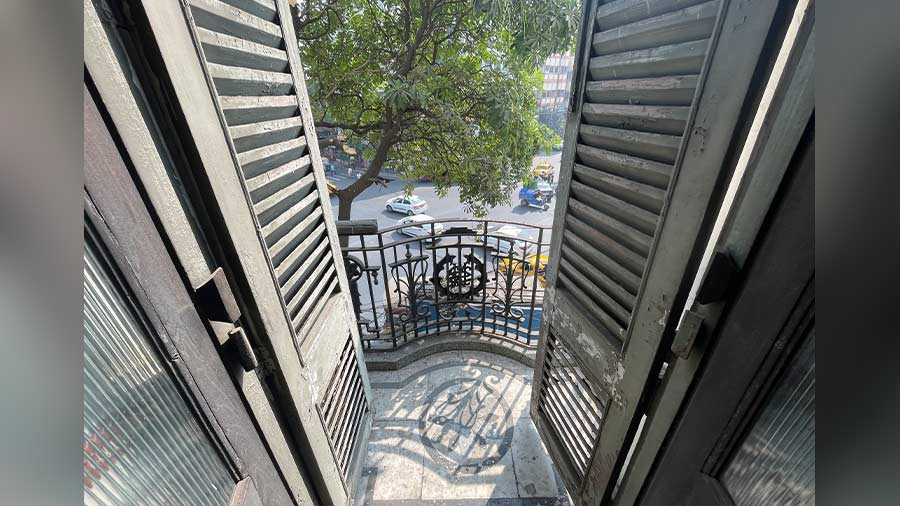
One of the verandahs, from where one can see four roads
But the decades fatigued the neighbourhood thereafter. The dust. The traffic. The noise. The limited car parks. The Seksarias introduced the last architectural dimension that their ancestors would have dismissed (sliding aluminium windows). Family members began pressing the case for south Calcutta. Septuagenarian Dinesh Seksaria left in 2016 to an Alipore he never knew. “I missed the sounds and smells of Burrabazar. There used to be the Jaipurias next door (long since gone on to become among the country’s largest carbonated beverage bottlers but in another city); there used to be Sharma’s that most Marwari families patronised at 10pm for garam doodh or dahi ka lassi based on the season; there was Ralli Singh and Nepal Chand Sweets. The character of the neighbourhood transformed. Even the 20-feet wide pavement shrunk to four feet.
Gradually, the rooms began to close. The apartments began to be stilled. Some rooms were rented to commercial premises. The gentry generalised.
‘I come here,’ says Dinesh Seksaria, “about four or five times… a year.” His last line: ‘Yahaan toh ek doosre ko dekhte bhi the…wahaan jaa-kar to band ho gaye.’
